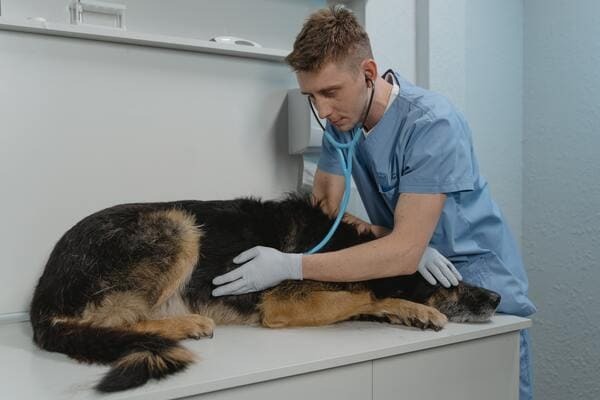

The Effects of Inflation on Veterinary Costs
Veterinary costs are rising due to inflation, affecting lab and vendor fees by up to 12%. Practices must raise prices to stay competitive and sustain economic growth. Animalia looks into the effects with veterinarians to help.

Writer Animalia Team
5 min read

It seems impossible to talk about veterinary costs without considering the elephant in the room: the current inflation rate. Inflation is at an all-time high, affecting almost every business sector —including the veterinary space, where Inflation has led to increases in lab and vendor fees, as much as 12% in some cases. How can practices stay competitive while sustaining economic growth? Raising prices, for one thing. Animalia looks into the inflation effects with the help of veterinarians.
Increased overhead costs
America’s worst bout of inflation in four decades has swollen the cost of your dog or cat’s visit to the vet. Prices for vet services have jumped 10% in the past year, government data shows — the biggest such spike on records dating back two decades: “Financial experts are recommending quarterly fee increases to help practices stay ahead of inflation and remain afloat”, says Dr. Paula Simons (DVM), an Emergency and Critical Care Resident from New England.

“The effects of inflation on pet care have been staggering’’, adds Dr. Sophie Whoriskey, DVM. “The rise in prices has put an even more significant strain on veterinary clinics and pet owners, as if the struggles of recovering from the pandemic were not enough. Clinics have struggled with being short-staffed and overbooked since the COVID-19 pandemic. The effects are still being seen nationwide. Now, we get to deal with the sinister impact of inflation”.
Raising salaries
Veterinary medicine is a labor-intensive service, with employee salaries composing almost 50% of the cost of running a clinic. With wages rising nationally at the fastest pace in decades, many clinic owners have had to pay more to find or keep employees. Those wage increases have typically been passed on to pet owners in the form of higher prices: “The cost of living has substantially risen, causing the need to increase salaries across the board to help veterinary professionals maintain their quality of life. That’s something you’ve got to open your eyes to in terms of inflationary impact. We’ve got to raise salaries but we don’t dare to without raising fees”, explains Dr. Simons.
Government data shows that hourly pay in the vet industry jumped 7% in August from a year earlier, well above the 5% average for all workers. Measured year over year, pay leapt 14.2% in January, the highest jump on records dating from 2007. In the meantime, many vets are still looking to hire, a sign that the inflationary pressure from rising wages may take a long time to ease.
Lab fees are accelerating
Other vet costs, including for medical supplies, lab testing fees and advanced pharmaceuticals, have accelerated, too. Fees for blood tests and other lab work rose 8% both in January and August. One factor in the rising cost of pet care is that it’s increasingly mimicking human health care. Specialty pet hospitals use MRI machines, expensive drugs have become available to fight cancer in pets and cats can receive kidney transplants. Vets and their technicians require advanced training to deliver such sophisticated services, which also can further inflate costs and the prices paid by consumers.
The effect on pet owners
“With healthcare being more expensive, pet owners are already suffering”, claims Dr. Sabrina Kong (DVM). “According to research conducted by LendingTree, at least 40% of US pet owners aren’t financially prepared to cover a veterinary emergency, therefore, most of these pet owners are likely (and willing) to end up in debt because of veterinary expenses”. In fact, at least 70% of pet owners have noticed a rise in their pet care expenses and 26% have confessed to struggling to afford pet care during these months.

“The increase in cost leads to financial strain for pet owners, particularly those on a fixed income or with limited financial resources”, adds Dr. Whoriskey. “As the cost of pet care products and services increases, it can become more difficult for these individuals to afford the necessary care for their pets. This can lead to pet owners cutting corners on their pets’ care or even relinquishing their pets to shelters.
Dr. Whoriskey is also concerned that the high pet care costs due to inflation can discourage pet ownership altogether: “If the cost of caring for a pet becomes too high, some individuals may decide not to get a pet at all, leading to a decline in pet ownership rates. This can have negative consequences for both pets and pet owners, as the human-animal bond has been shown to have numerous physical and mental health benefits”.
“Additionally, if wages do not keep up with the rate of inflation, pet owners may have less disposable income available to spend on their pets, which could also impact the amount they are able to spend on pet care”, agrees Dr. Melissa M. Brock (DVM).
Finally, high pet care costs can lead to a decline in the overall health of the pet population: “If pet owners cannot afford necessary veterinary care or high-quality pet food , their pets may suffer from poor health’, warns Dr. Whoriskey. “This can lead to increased suffering for pets and higher costs for pet owners in the long run, as untreated health problems can lead to more severe and costly issues down the road”.
Dr. Simons suggests a creative solution: “The solution, in my opinion, is pet insurance. It guarantees owners pay less out of pocket and can be prepared when expensive emergencies arise”.





We offer the most
comprehensive coverage
out there
car with a spare tire for life’s bumps.
Having Animalia is like a pimped-out
Rolls Royce with a swimming pool
in the trunk.



Get your pet insurance quote
Pet type
- Dog
- Cat
What is your pet's name?
Zip code





